One of the hazards associated with being a neuroscientist is that you see the world through neural-colored glasses: everything relates back to brain functioning in some way or another. I suppose this can probably be said about any number of professions, and I may be biased, but I think neuro-geeks (myself included) have a particularly interesting view of the world. Let me give you an example.
When I was pregnant with my first child, I wondered about a lot of things that most first-time parents wonder about: what would the baby be like? what would s/he look like? how would my life change? My husband, not a neuroscientist, shared these questions and we’d spend hours talking about our future filled with little socks, little cries, and this little person I was growing inside of me.
I did have one question that I did not voice to my husband until I had posed it to a friend of mine, a fellow neuroscientist, at work. After I posed the question to my friend, we spent lunch discussing whether my question had merit, whether anyone else had posed the question, and how we might design a study to answer the question from both a behavioral and neurophysiological perspective. After I posed the question to my husband, he just looked at me funny.
My question was this: how was the neural representation of my belly region changing throughout during my pregnancy? As I envisioned my baby going from the size of a blueberry to grapefruit to cantaloupe (seriously, what is it with pregnancy sites that equate fetus size with edible goods?), I couldn’t help but wonder about the size of my homunculus’ belly region. For those who think I am referring to some alter ego, let me explain.
The homunculus, Latin for “little man”, is a representation of a human body. With regards to brain function, there are many representations of the homunculus throughout the brain. The one I am referring to here is the somatosensory homunculus which is located in a strip of cortex that runs roughly from one’s ear to the top of the head. Different areas of the body send touch information to this part of the brain so that we can perceive the texture, temperature, size, and shape of objects that we come into contact with. This area also receives information about painful stimuli and body position.
Here’s the interesting part though: areas of the body (i.e. your fingers) that are more sensitive to touch stimuli are granted more cortical real estate than areas of the body (i.e. your back) that are not as sensitive. This is a bit of a chicken-and-egg problem though: the size of brain area allocated to a body part is proportional to how sensitive it is, but the sensitivity of that body part is proportional to the size of brain area allocated to it.
So what did this all have to do with the size of my ever-expanding belly? I wondered if my belly was becoming more sensitive since my baby kept kicking me. Could this sustained touch stimulation lead to changes in the extent and connections within and between cortical regions devoted to analyzing touch sensations from my belly? Or in other words, was my homunculus’s belly region expanding as well?
There are a few ways to answer this question experimentally, but many methods were thrown out of consideration right away since I wasn’t willing to have an electrode placed in my brain or be placed inside an fMRI machine. Being a behavioral neuroscientist, I decided that using a behavioral measure might work best. The two-point threshold is a measure of how far apart two points need to be before you feel them as two separate points, as opposed to just one point. Thresholds vary as a function of the sensitivity of the body part where the threshold is taken. For example, the two points need to be much further apart on your back as compared to your arm before you feel two points and not one. I reasoned that the threshold would change over the course of my pregnancy, making my belly more sensitive over time.
I never did the experiment, but a recent study that measured two-point thresholds in pregnant women found no change in sensitivity as the pregnancy progressed. In fact, they found that pregnant women enjoy a decrease in sensitivity compared to non-pregnant women.
So there you have it. One more mystery explained by the powers of neuroscientific research. Now my husband can look at me funny for other reasons.


















